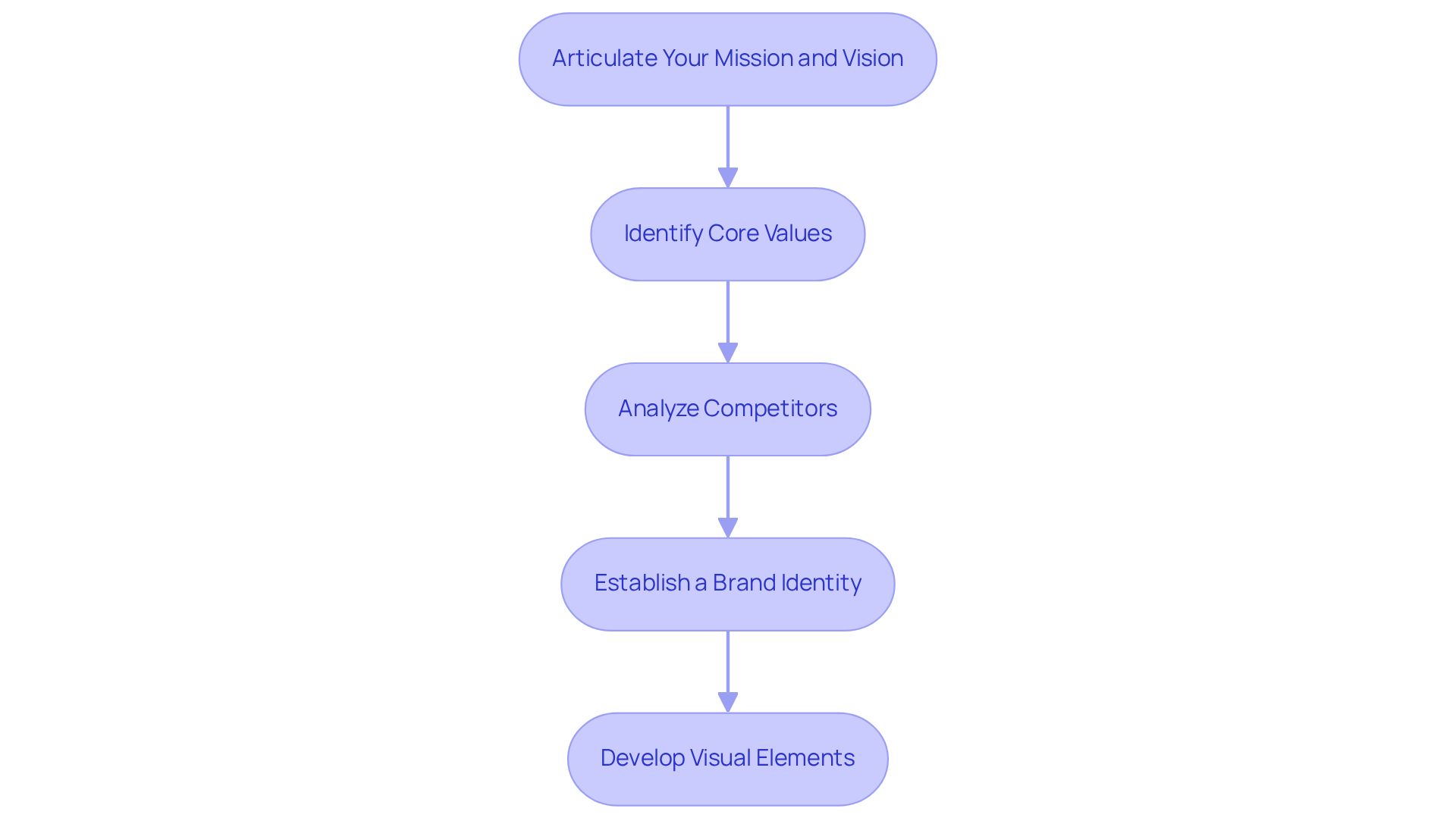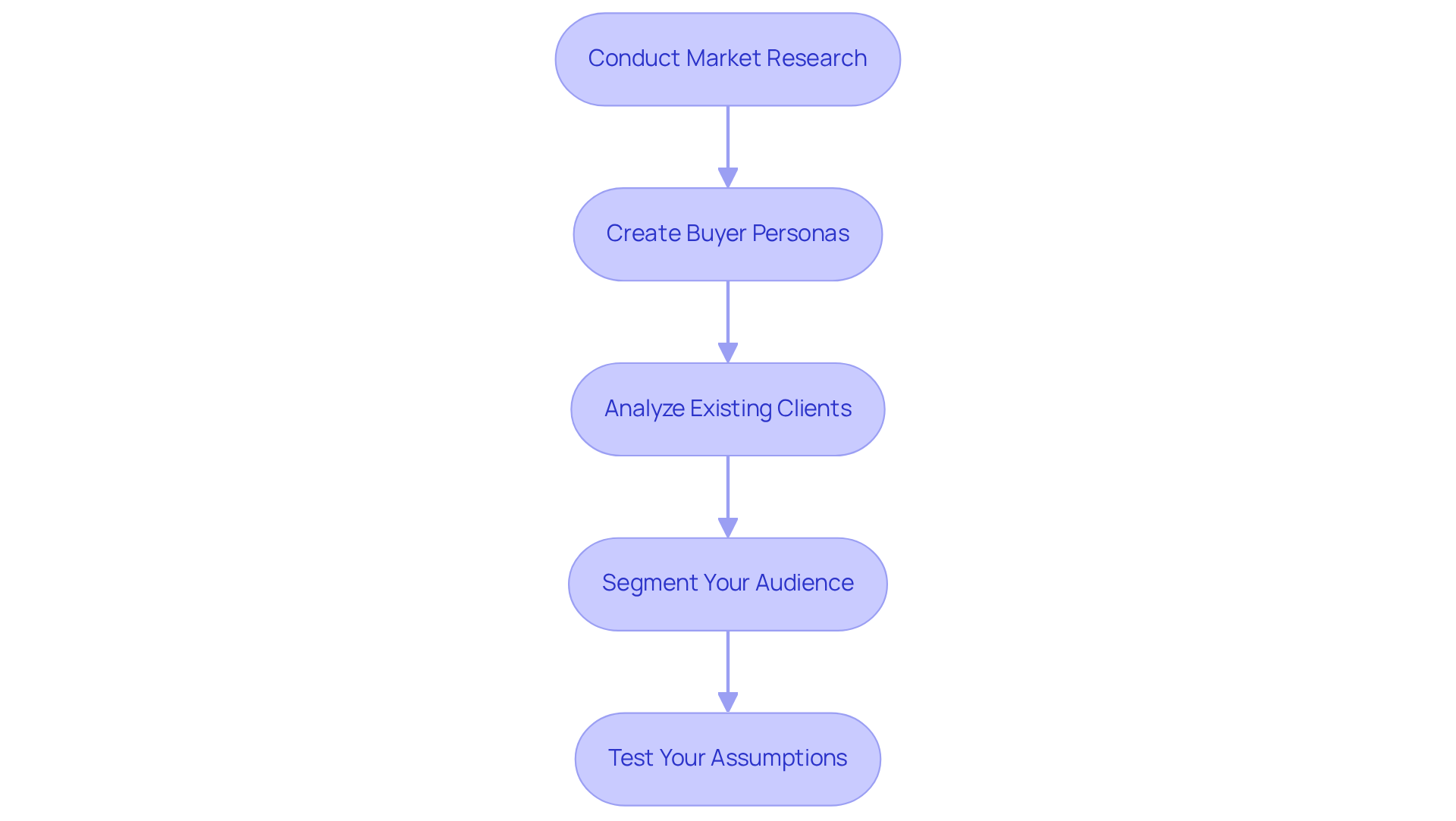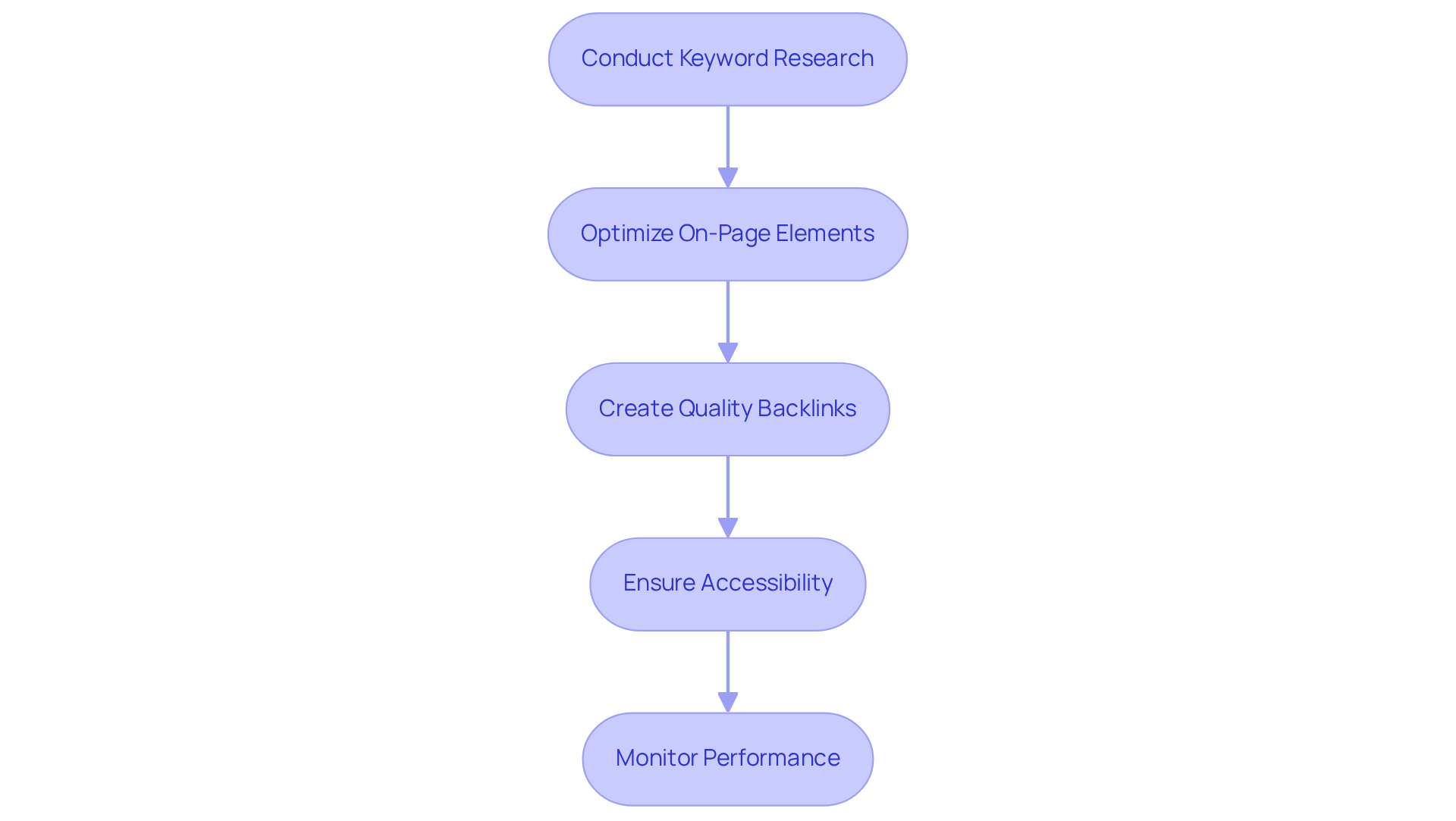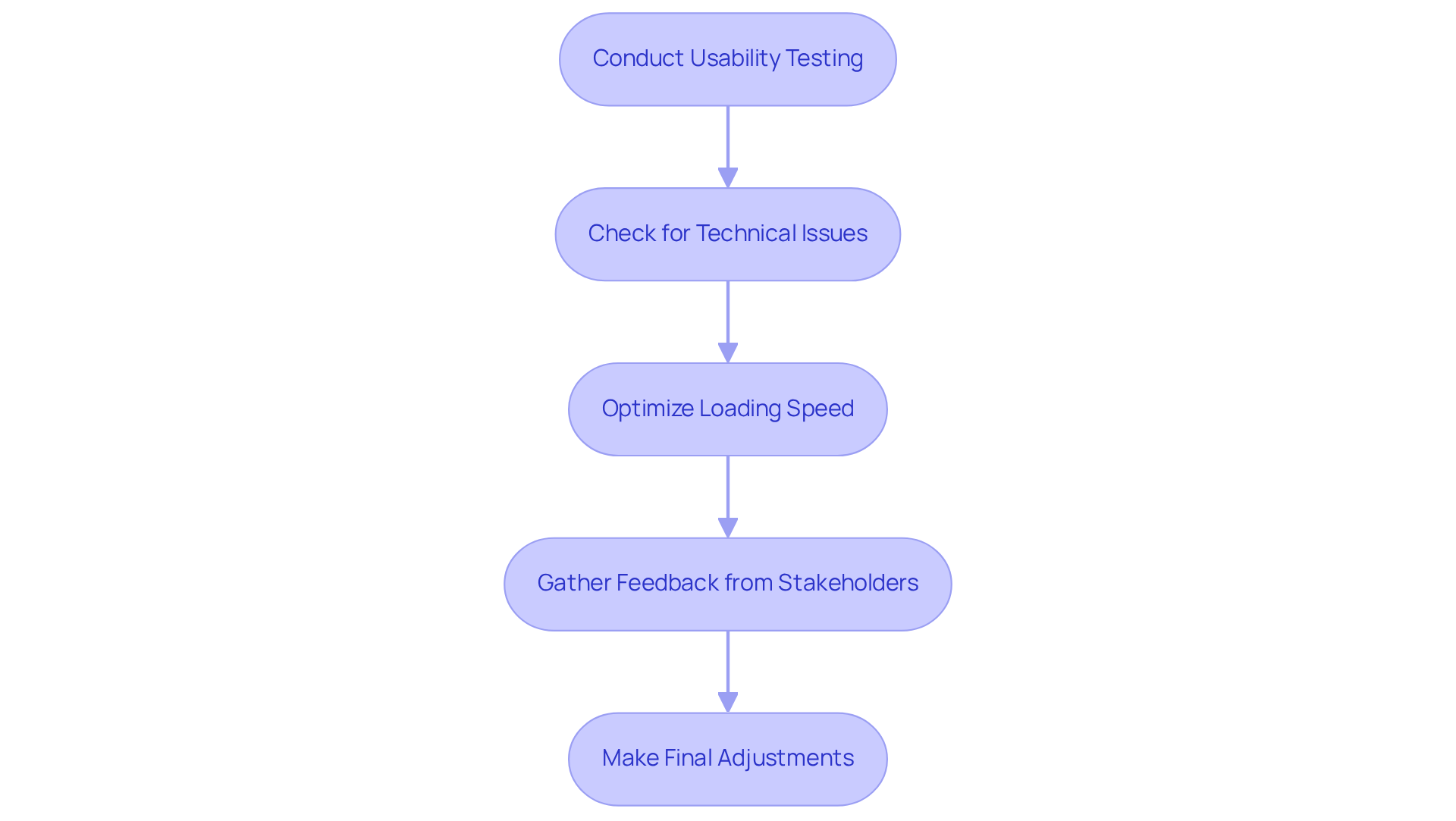Overview
This article outlines six essential steps to master agency website design, focusing on defining brand identity, understanding target audiences, creating effective layouts, crafting compelling content, optimizing for SEO and accessibility, and refining the website before launch. Each step is supported by actionable strategies and insights, emphasizing the importance of a cohesive brand narrative, user engagement, and continuous improvement to create a successful online presence.
-
Define Brand Identity: Establish a clear and compelling brand identity that resonates with your target audience. This foundational step sets the tone for your entire website.
-
Understand Target Audiences: Conduct thorough research to understand who your audience is. Tailoring your design to meet their needs is crucial for engagement.
-
Create Effective Layouts: Design layouts that guide users intuitively through your content. A well-structured layout enhances user experience and keeps visitors engaged.
-
Craft Compelling Content: Content is king. Ensure your messaging is not only informative but also engaging, encouraging users to explore further.
-
Optimize for SEO and Accessibility: Implement SEO best practices to improve visibility and ensure your website is accessible to all users, including those with disabilities.
-
Refine Before Launch: Before going live, refine your website based on feedback and testing. Continuous improvement is key to maintaining a successful online presence.
By following these steps, you can create a website that not only looks great but also performs well, driving engagement and conversions. Ready to elevate your agency's online presence? Let's get started!
Introduction
Crafting an effective agency website design transcends mere aesthetics; it stands as a crucial extension of a brand's identity and mission. By mastering the intricacies of website design, agencies can forge a powerful online presence that resonates with their target audience and drives engagement. Yet, the challenge lies in navigating a myriad of design elements—from defining a compelling brand narrative to optimizing for user experience and SEO.
How can agencies ensure their website not only reflects their unique identity but also meets the evolving needs of their audience? This question is pivotal. A well-designed website can captivate visitors, foster trust, and ultimately convert them into loyal clients.
To achieve this, agencies must focus on:
- Creating a seamless user experience
- Integrating effective SEO strategies
- Telling a compelling brand story
By doing so, they not only enhance their visibility but also establish a deeper connection with their audience.
In this competitive landscape, the right website design can be the differentiator that propels an agency forward. It's time to elevate your online presence and engage your audience like never before.
Define Your Agency's Brand Identity
Defining your agency's identity starts with a thoughtful exploration of your mission, vision, and core values. At Overskies, we assert that a compelling narrative is crucial for a strong market presence. Follow these essential steps to create a narrative that truly resonates:
-
Articulate Your Mission and Vision: Craft a concise statement that encapsulates your agency's purpose and aspirations. This statement should resonate with both your team and your clients, serving as a guiding light for all branding efforts.
-
Identify Core Values: Enumerate the principles that shape your agency's culture and client relationships. These values are vital for fostering trust and consistency in your messaging, aligning with Overskies' philosophy of developing strong identities.
-
Analyze Competitors: Conduct thorough research on your competitors to understand their branding strategies. Identify market gaps that your agency can uniquely address, allowing you to differentiate your offerings. At Overskies, we leverage consumer research to distinctly outline and target ideal personas, ensuring your identity stands out.
-
Establish a Brand Identity: Define the tone and voice of your identity. Consider whether your agency should come across as formal, friendly, innovative, or traditional. This personality will influence the language and agency website design of your website, ensuring it is consistent with your identity. Our proprietary Storytelling Process at Overskies guarantees that your company's purpose resonates with your target audience, driving recognition and building advocates.
-
Develop Visual Elements: Choose colors, fonts, and logos that genuinely reflect your identity. Consistency in these visual elements across all platforms is crucial for reinforcing your identity and enhancing recognition. Overskies emphasizes the importance of a cohesive visual identity to elevate brand narratives through creative design.
By diligently following these steps, you will establish a robust foundation for your agency website design that not only resonates with your intended demographic but also authentically reflects your agency's unique identity.

Identify Your Target Audience and Their Needs
To effectively identify your target audience, follow these essential steps:
-
Conduct Market Research: Start by utilizing surveys, interviews, and analytics to gather valuable data about potential clients. Understand their demographics, preferences, and pain points. By leveraging AI, you can enhance this process, gaining hyper-personalized insights tailored to individual customer preferences, which leads to more accurate data collection.
-
Create Buyer Personas: Develop detailed profiles of your ideal clients, encompassing their goals, challenges, and how your agency can assist them. AI tools can analyze customer interactions, refining these personas further to ensure they reflect real-world behaviors and needs.
-
Analyze Existing Clients: Examine your current client base to identify common traits and requirements that can guide your design. AI can recognize patterns in customer behavior, enhancing your understanding of what works and what doesn’t.
-
Segment Your Audience: Divide your audience into segments based on shared traits or behaviors. This segmentation allows for more personalized content and design. AI-driven analytics can automate this process, ensuring precision and efficiency in targeting.
-
Test Your Assumptions: Conduct A/B testing on your platform to determine which designs and content resonate most effectively with various groups. AI can optimize these tests by predicting outcomes based on previous data, allowing for more informed decisions.
By understanding your audience and leveraging AI, you can develop an agency website design that directly addresses their needs and encourages engagement. Take action now to refine your approach and enhance your connection with your target audience.

Design the Website Layout and User Experience
To design an effective website layout and user experience, follow these essential steps:
- Create a Site Map: Start by outlining the structure of your online presence, including main pages and subpages. This not only aids in visualizing the journey of the individual but also sets a solid foundation for navigation.
- Prioritize Navigation: Your online platform must be easy to navigate. Use clear labels and a logical hierarchy to guide individuals seamlessly through your content.
- Focus on Visual Hierarchy: Employ size, color, and placement strategically to highlight crucial elements, such as calls to action (CTAs) and key information. This ensures that users can quickly identify what matters most.
- Incorporate Responsive Design: Make certain your online presence is mobile-friendly and visually appealing across all devices. With a growing number of individuals accessing platforms via smartphones, this step is non-negotiable.
- Utilize White Space: Avoid overcrowding your pages. Effectively using white space creates a clean, organized look that enhances readability and user engagement.
By implementing these steps, you will not only create a website layout that is visually appealing but also functional and user-friendly. Take action now to elevate your online presence and engage your audience effectively.

Create Compelling Content and Visuals
To create compelling content and visuals, follow these steps:
-
Create a Content Strategy: Clearly outline the types of content you will produce, such as blogs, case studies, and videos, ensuring they align with the needs and preferences of your target demographic. A well-defined strategy is essential for guiding your creative efforts and maximizing impact.
-
Write Engaging Copy: Use clear and concise language that reflects your brand voice. Focus on benefits rather than features to forge an emotional connection with your audience. Research indicates that 75% of people judge a company's credibility based on its website appearance, making effective copy crucial.
-
Incorporate Visuals: Utilize high-quality images, videos, and graphics that complement your content and enhance the user experience. Ensure these visuals align with your identity, as they play a significant role in capturing attention and conveying your message effectively. Engaging visuals are crucial for conveying your business's unique narrative and distinguishing it in today's competitive environment.
-
Utilize Storytelling Techniques: Weave narratives into your content to make it more relatable and memorable. Successful agencies, like Overskies, often share client success stories or case studies, illustrating their impact and fostering a deeper connection with potential clients. Insights from the state of brand storytelling research reveal how effective narratives can significantly enhance engagement and lead generation, as demonstrated by Overskies' collaboration with various clients.
-
Include Calls to Action: Strategically position CTAs throughout your content to direct visitors toward desired actions, such as reaching out to your agency or subscribing to a newsletter. This method not only improves audience engagement but also boosts conversions.
By concentrating on a strong content strategy and engaging visuals, you will develop an online platform that not only educates but also enthralls your viewers, ultimately resulting in increased brand loyalty and business achievement.

Optimize for SEO and User Accessibility
To optimize your website for SEO and user accessibility, follow these essential steps:
-
Conduct Keyword Research: Start by identifying relevant keywords that your target audience is actively searching for. Utilize tools like Google Keyword Planner to uncover high-traffic terms that can drive visitors to your site.
-
Optimize On-Page Elements: Make sure that titles, meta descriptions, headers, and image alt texts incorporate your target keywords. This not only enhances SEO but also improves user experience.
-
Create Quality Backlinks: Develop a robust strategy for acquiring backlinks from reputable sites. This will significantly boost your site's authority and improve its search ranking.
-
Ensure Accessibility: Adhere to WCAG (Web Content Accessibility Guidelines) to make your online platform usable for individuals with disabilities. This includes using alt text for images and ensuring seamless keyboard navigation.
-
Monitor Performance: Leverage tools like Google Analytics to track your site's performance. Use the data to make informed adjustments that enhance both SEO and accessibility.
By implementing these strategies, you will not only expand your site's reach but also ensure it is accessible to everyone. Take action now to elevate your online presence!

Test and Refine Your Website Before Launch
To effectively test and refine your website prior to launch, follow these essential steps:
-
Conduct Usability Testing: Involve real users to navigate your site, gathering valuable insights on their experiences. Pay close attention to areas where they encounter difficulties and aspects they find enjoyable. As Allison Corr states, "Usability is the ability for someone to access your product or service, complete the tasks they need, and achieve whatever goal or outcome they expect."
-
Check for Technical Issues: Rigorously test all links, forms, and interactive elements to confirm their functionality. Utilize tools like Google Search Console to pinpoint and rectify any errors.
-
Optimize Loading Speed: Analyze your site's loading speed using tools such as GTmetrix. Aim for a loading time under three seconds, as studies indicate that a delay of just one second can decrease retention by 7%.
-
Gather Feedback from Stakeholders: Share the website with team members and trusted clients to collect their insights and suggestions for enhancements. This collaborative approach can uncover blind spots and improve overall design.
-
Make Final Adjustments: Based on the feedback and testing results, apply necessary modifications to enhance experience and functionality. Ensure that all adjustments align with user needs and expectations.
By meticulously testing and refining your website, you will set the stage for a successful launch that resonates with your audience and meets their needs.

Conclusion
Mastering agency website design is a multifaceted journey that starts with a clear understanding of brand identity and culminates in a user-friendly, engaging online presence. By following the outlined steps, agencies can craft a cohesive narrative that not only reflects their core values but also resonates with their target audience. A robust brand identity, paired with a thoughtful approach to design and content, is essential for standing out in a competitive market.
Key insights from this article highlight the critical role of:
- Market research
- Audience segmentation
- Effective content creation
Understanding the needs of potential clients and leveraging data-driven strategies can significantly enhance the overall design and functionality of an agency's website. Moreover, prioritizing SEO and accessibility ensures that the site reaches a broader audience while delivering a seamless user experience.
Ultimately, the success of an agency website hinges on the continuous refinement of its design and content based on user feedback and performance metrics. Embracing these best practices not only elevates the agency's online presence but also fosters deeper connections with clients. Taking actionable steps today will pave the way for a compelling and effective agency website that truly embodies the brand's identity and meets the evolving needs of its audience.
Frequently Asked Questions
How can I define my agency's brand identity?
Start by exploring your mission, vision, and core values. Articulate a concise statement that encapsulates your agency's purpose and aspirations, identify the principles that shape your culture, analyze competitors, establish a brand identity, and develop visual elements that reflect your identity.
What steps should I take to articulate my agency's mission and vision?
Craft a concise statement that captures your agency's purpose and aspirations, ensuring it resonates with both your team and clients. This statement should serve as a guiding light for all branding efforts.
Why are core values important for my agency?
Core values shape your agency's culture and client relationships, fostering trust and consistency in messaging. They align with your agency's identity and enhance brand recognition.
How can I analyze my competitors effectively?
Conduct thorough research on competitors to understand their branding strategies and identify market gaps that your agency can uniquely address. This will help you differentiate your offerings.
What is involved in establishing a brand identity?
Define the tone and voice of your agency, considering whether it should be formal, friendly, innovative, or traditional. This personality will influence your website's language and design, ensuring consistency with your identity.
How do I develop visual elements for my brand?
Choose colors, fonts, and logos that genuinely reflect your agency's identity. Consistency in these visual elements across all platforms is crucial for reinforcing your identity and enhancing brand recognition.
What steps should I follow to identify my target audience?
Conduct market research using surveys, interviews, and analytics to gather data about potential clients. Create buyer personas, analyze existing clients, segment your audience, and test your assumptions through A/B testing.
How can AI enhance the process of identifying my target audience?
AI can provide hyper-personalized insights tailored to individual customer preferences, analyze customer interactions to refine buyer personas, recognize patterns in behavior, and automate audience segmentation for precision and efficiency.
What is the importance of testing assumptions about my audience?
Conducting A/B testing allows you to determine which designs and content resonate most effectively with different groups. AI can optimize these tests by predicting outcomes based on previous data, leading to more informed decisions.
.png?width=250&height=153&name=CSI-OverskiesRebrand_LOGO-01(smaller).png)

.png?width=100&height=61&name=CSI-OverskiesRebrand_LOGO-01(smaller).png)


.png?width=88&name=CSI-OverskiesRebrand_LOGO-01(smaller).png)



